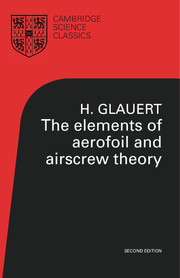Book contents
- Frontmatter
- PREFACE
- PREFACE TO SECOND EDITION
- Contents
- REFERENCES
- Chap. I Introduction
- Chap. II Bernoulli's Equation
- Chap. III The Stream Function
- Chap. IV Circulation and Vorticity
- Chap. V The Velocity Potential and the Potential Function
- Chap. VI The Transformation of a Circle into an Aerofoil
- Chap. VII The Aerofoil in Two Dimensions
- Chap. VIII Viscosity and Drag
- Chap. IX The Basis of Aerofoil Theory
- Chap. X The Aerofoil in Three Dimensions
- Chap. XI The Monoplane Aerofoil
- Chap. XII The Flow round an Aerofoil
- Chap. XIII Biplane Aerofoils
- Chap. XIV Wind Tunnel Interference on Aerofoils
- Chap. XV The Airscrew: Momentum Theory
- Chap. XVI The Airscrew: Blade Element Theory
- Chap. XVII The Airscrew: Wind Tunnel Interference
- Appendix
- Bibliography
- Index
- Frontmatter
- PREFACE
- PREFACE TO SECOND EDITION
- Contents
- REFERENCES
- Chap. I Introduction
- Chap. II Bernoulli's Equation
- Chap. III The Stream Function
- Chap. IV Circulation and Vorticity
- Chap. V The Velocity Potential and the Potential Function
- Chap. VI The Transformation of a Circle into an Aerofoil
- Chap. VII The Aerofoil in Two Dimensions
- Chap. VIII Viscosity and Drag
- Chap. IX The Basis of Aerofoil Theory
- Chap. X The Aerofoil in Three Dimensions
- Chap. XI The Monoplane Aerofoil
- Chap. XII The Flow round an Aerofoil
- Chap. XIII Biplane Aerofoils
- Chap. XIV Wind Tunnel Interference on Aerofoils
- Chap. XV The Airscrew: Momentum Theory
- Chap. XVI The Airscrew: Blade Element Theory
- Chap. XVII The Airscrew: Wind Tunnel Interference
- Appendix
- Bibliography
- Index
Summary
The aim of aerofoil theory is to explain and to predict the force experienced by an aerofoil, and a satisfactory theory has been developed in recent years for the lift force in the ordinary working range below the critical angle and for that part of the drag force which is independent of the viscosity of the air. Considerable insight has also been obtained into the nature of the viscous drag and into the behaviour of an aerofoil at and above the critical angle, but the theory remains at present in an incomplete state. The problem of the airscrew is essentially a part of aerofoil theory, since the blades of an airscrew are aerofoils which describe helical paths, and a satisfactory theory of the propulsive airscrew has been developed by extending the fundamental principles of aerofoil theory.
The object of this book is to give an account of aerofoil and airscrew theory in a form suitable for students who do not possess a previous knowledge of hydrodynamics. The first five chapters give a brief introduction to those aspects of hydrodynamics which are required for the development of aerofoil theory. The following chapters deal successively with the lift of an aerofoil in two dimensional motion, with the effect of viscosity and its bearing on aerofoil theory, and with the theory of aerofoils of finite span. The last three chapters are devoted to the development of airscrew theory.
- Type
- Chapter
- Information
- Publisher: Cambridge University PressPrint publication year: 1983



